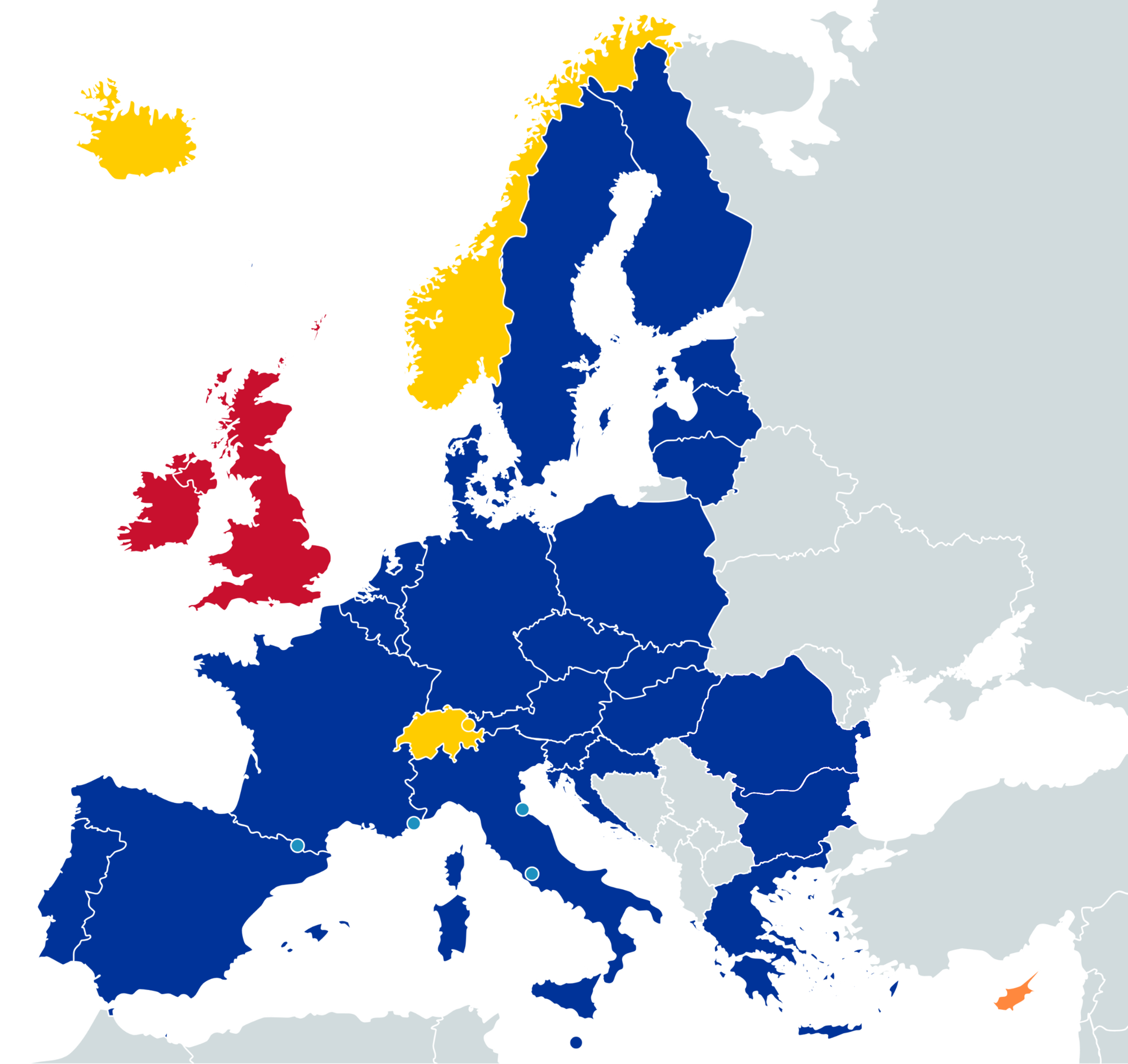Understanding the Schengen Area: A Complete Guide for American Families

Planning a European adventure with your family? Understanding the Schengen Area is crucial for any American traveler heading to Europe. The Schengen zone allows visa-free travel for US citizens across 29 European countries for up to 90 days within any 180-day period. After nearly three years of worldschooling across Europe with our three daughters, we've learned firsthand how these rules work in practice and why they matter for family travel planning.
During our initial European journey in 2022, we spent 2.5 months moving through eight Schengen countries without thinking twice about visa requirements. However, understanding these rules becomes critical when planning longer stays or multiple European trips throughout the year.
What is the Schengen Area?
The Schengen Area is a zone of 29 European countries that have abolished passport controls at their mutual borders, allowing free movement of people between member states. Named after the Luxembourg village where the original agreement was signed in 1985, this zone operates as a single country for travel purposes.
For American families, this means you can enter one Schengen country and travel freely to all others without additional border checks or visa requirements. When we took the train from Paris to Munich in 2022, we didn't show our passports once during the journey, despite crossing international borders.
The Schengen Agreement created the world's largest free-travel zone, covering an area of 4.3 million square kilometers and serving over 400 million people. This makes European family travel significantly easier than navigating visa requirements for individual countries.

*Azores, Madeira and Canary Islands are also in the Schengen Area.
How Do You Say Schengen?
The correct pronunciation is "SHEN-gen" (rhymes with "pen-gen"), not "SHENG-en" as many Americans initially assume. The area takes its name from Schengen, Luxembourg, the small wine-making village where European leaders signed the original agreement on June 14, 1985.
Current Schengen Countries: The Complete List
As of 2025, 29 countries participate in the Schengen Area. Here's the complete breakdown:
EU Countries in Schengen (25 countries)
- Austria
- Belgium
- Bulgaria (full member since January 1, 2025)
- Croatia
- Czech Republic
- Denmark
- Estonia
- Finland
- France
- Germany
- Greece
- Hungary
- Italy
- Latvia
- Lithuania
- Luxembourg
- Malta
- Netherlands
- Poland
- Portugal
- Romania (full member since January 1, 2025)
- Slovakia
- Slovenia
- Spain
- Sweden
Non-EU Countries in Schengen (4 countries)
- Iceland
- Liechtenstein
- Norway
- Switzerland
Special Status Countries (2 countries)
- Monaco (de facto member through France)
- Vatican City (de facto member through Italy)
Notable EU Countries NOT in Schengen
Several European Union member countries remain outside the Schengen zone:
- Cyprus - Expected to join by the end of 2025
- Ireland - Maintains common travel area with UK
Evolution of the Schengen Area: From 5 to 29 Countries
The Schengen zone has expanded dramatically since its humble beginnings:
| Year | Countries Added | Total Countries | Major Milestone |
|---|---|---|---|
| 1985 | 5 (Belgium, France, Germany, Luxembourg, Netherlands) | 5 | Original Schengen Agreement signed |
| 1990 | None | 5 | Schengen Convention signed |
| 1995 | +2 (Portugal, Spain) | 7 | Agreement comes into effect |
| 1997 | +2 (Italy, Austria) | 9 | First southern expansion |
| 2001 | +4 (Greece, Denmark, Finland, Sweden) | 13 | Nordic countries join |
| 2007 | +9 (Czech Republic, Estonia, Hungary, Latvia, Lithuania, Malta, Poland, Slovakia, Slovenia) | 22 | Major eastern expansion |
| 2008 | +1 (Switzerland) | 23 | First non-EU country joins |
| 2011 | +1 (Liechtenstein) | 24 | Smallest country joins |
| 2024 | +2 (Bulgaria, Romania for air/sea) | 27 | Partial expansion |
| 2025 | +2 (Bulgaria, Romania full) | 29 | Latest expansion |
The expansion reflects Europe's growing integration and the success of free movement policies. Each addition required existing members to vote unanimously, ensuring new countries met strict security and border control standards. The most recent expansion occurred on January 1, 2025, when Bulgaria and Romania became full Schengen members, completing their transition that began with air and sea border lifting in March 2024.
Schengen vs Eurozone vs European Union: The Key Differences
Many travelers confuse these three distinct European zones. Here's how they differ:
The Schengen Area (29 countries)
- Purpose: Free movement of people
- Key feature: No border controls between member states
- Membership: Includes both EU and non-EU countries
- Travel impact: Americans can visit all 29 countries on single entry
The Eurozone (20 countries)
- Purpose: Common currency (Euro)
- Key feature: Shared monetary policy
- Membership: Only EU countries can join
- Travel impact: No need to exchange currency between member states
The European Union (27 countries)
- Purpose: Political and economic union
- Key feature: Common laws, policies, and institutions
- Membership: Requires meeting strict political and economic criteria
- Travel impact: Citizens have right to live and work in any member state
Countries That Belong to All Three
Only 17 countries belong to all three zones: Austria, Belgium, Estonia, Finland, France, Germany, Greece, Italy, Latvia, Lithuania, Luxembourg, Malta, Netherlands, Portugal, Slovakia, Slovenia, and Spain.
US Citizens and Schengen Travel: What You Need to Know
Do US Citizens Need a Schengen Visa?
No, US citizens do not need a visa for short-term tourism in the Schengen Area. Americans can enter visa-free for up to 90 days within any 180-day period. This applies to tourism, business meetings, and short-term family visits.
However, this changes in late 2025 when the European Travel Information and Authorization System (ETIAS) launches. US citizens will need to apply for this electronic authorization before traveling, though it's not technically a visa.
The Critical 90-Day Rule Explained
The Schengen 90-day rule is the most important regulation for American travelers to understand. You can stay in the Schengen Area for 90 days out of any 180-day period. This is a rolling calculation, not a calendar period.
Practical Example: If you enter the Schengen Area on January 1 and stay for 90 days (until March 31), you cannot return until July 1. The 180-day period rolls forward each day.
During our 2022 European journey, we spent exactly 75 days in Schengen countries before flying to Thailand. We could have returned to Europe after spending time outside the Schengen area, but we chose to explore Asia instead.
Common 90-Day Rule Mistakes
- Thinking it resets each calendar year: The 180-day period is rolling, not calendar-based
- Assuming departure resets the clock: You must stay out for the full required period
- Forgetting about micro-states: Monaco and Vatican City count toward your 90 days
- Not tracking accurately: Immigration doesn't remind you of your remaining days
How Strict is the Schengen Visa Process?
For visa-free travel, entry requirements are generally straightforward but enforced consistently:
Entry Requirements for Americans:
- Valid US passport (must be valid for at least 3 months beyond intended departure)
- Proof of onward travel (return ticket or travel to non-Schengen country)
- Sufficient funds (roughly 65 euros per day)
- Travel insurance (recommended but not always required)
Border officials can ask for any of these documents, though in practice, they rarely check everything for short-term tourists. During our multiple Schengen entries, we've only been asked for return tickets once, but it's always wise to have documentation ready.
Planning Multi-Country European Travel
Our Schengen Strategy for Families
During our European travels, we've developed strategies for maximizing Schengen time:
Base Selection: Choose one or two countries as home bases rather than constantly moving. We spent 3-4 weeks each in Germany, Czech Republic, and Italy during our first European leg.
Non-Schengen Breaks: Plan trips to non-Schengen countries like the UK, Ireland, or countries outside Europe to reset your 90-day clock.
Entry Point Strategy: Enter through countries with shorter immigration lines. Smaller airports often process families faster than major hubs.
Recommended Schengen Itineraries for Families
First-Time Europe (30 days):
- Germany (Munich/Bavaria): 10 days
- Austria (Vienna/Salzburg): 7 days
- Italy (Rome/Florence): 10 days
- France (Paris): 3 days
Central Europe Focus (45 days):
- Czech Republic (Prague): 14 days
- Hungary (Budapest): 10 days
- Poland (Krakow/Warsaw): 14 days
- Germany (Berlin/Dresden): 7 days
Countries Not Part of Schengen
Several European countries remain outside the Schengen zone, offering opportunities to extend European stays:
Major Non-Schengen European Countries
- United Kingdom: Requires separate visa/entry
- Ireland: Common travel area with UK
- Turkey: Separate visa requirements
- Serbia: Visa-free for Americans (separate from Schengen)
- Bosnia and Herzegovina: Visa-free for Americans
- Montenegro: Visa-free for Americans
- North Macedonia: Visa-free for Americans
These countries can be great additions to a European itinerary while staying compliant with Schengen rules.
Coming Changes: Entry/Exit System and ETIAS
Two major digital systems are launching in the coming months that will affect American travelers:
Entry/Exit System (EES) - October 2025
Starting in October 2025, the EU will implement the Entry/Exit System, which will:
- Replace passport stamping with digital registration
- Use biometric data (fingerprints and facial scans)
- Automatically track your 90-day allowance
- Launch progressively over 6 months starting with 50% of border crossings
The EES applies to all non-EU visitors entering the Schengen area for short stays, including Americans traveling visa-free.
ETIAS Authorization - Late 2025/Early 2026
Following the EES launch, the European Travel Information and Authorization System will require US citizens to:
- Apply online before traveling (similar to US ESTA system)
- Pay approximately 7 euros for adults (free for children under 18)
- Obtain authorization valid for three years or until passport expires
- Apply a few days before travel
ETIAS won't significantly impact family travel planning, but adds another preparation step.
Practical Tips for Schengen Travel with Kids
Documentation Management
Keep digital and physical copies of all passports. We use a secure cloud folder accessible offline for emergency situations. Make sure all family members' passports have the required validity period.
Staying Connected
Reliable internet becomes crucial when managing multi-country travel and tracking your Schengen days. We use Holafly eSIM with code ADAMANDLINDS for 5% off European data plans. Having consistent connectivity helps with navigation, translation apps, and staying in touch with family back home. While not always required, comprehensive travel insurance becomes crucial when traveling with children in the Schengen area. We use SafetyWing Nomad Insurance which covers our family across all Schengen countries.
Travel Insurance Considerations
Register with the US State Department's STEP program when traveling long-term in Europe. This free service provides security updates and helps the embassy locate you in emergencies.
Emergency Preparedness
Costs vary dramatically between Schengen countries. Our family of five spent:
- Western Europe (Germany, France): $175-225 per day
- Southern Europe (Spain, Italy): $140-175 per day
- Central Europe (Czech Republic, Hungary): $100-140 per day
- Baltic States (Estonia, Latvia): $80-120 per day
These budgets include accommodation, food, transportation, and activities for a family of five staying 2-4 weeks in each location.
Making the Most of Schengen Freedom
The beauty of the Schengen Area lies in its seamless travel experience. When we took the train from Munich to Prague, or drove from Austria to Hungary, the absence of border controls made Europe feel like one unified destination rather than separate countries.
This freedom allows families to plan organic itineraries, following interests and weather rather than rigid visa schedules. If your kids fall in love with a German Christmas market, you can extend your stay without visa complications. If Barcelona's beaches call to you longer than planned, you have the flexibility to adjust.
For worldschooling families particularly, Schengen freedom enables educational opportunities that would be impossible with individual country visas. Our daughters experienced Roman history in Italy, medieval architecture in Czech Republic, and Alpine culture in Austria, all on a single entry.
Planning Your Schengen Adventure
Ready to explore Europe with your family? Start by choosing 2-3 base countries that offer different cultural experiences while staying within the 90-day limit. Consider transportation connections, accommodation costs, and your family's interests when planning your route.
Remember that the Schengen Area offers some of the world's best family travel infrastructure, from extensive train networks to family-friendly accommodations and activities. The combination of visa-free travel and excellent logistics makes Europe an ideal destination for families taking their first extended international trip.
Contact Lindsay at [email protected] for personalized European travel planning that maximizes your Schengen time while creating unforgettable family memories.
Whether you're planning a two-week family vacation or considering a longer worldschooling adventure, understanding the Schengen Area rules ensures you can focus on creating memories rather than worrying about logistics. Europe awaits your family's exploration.





